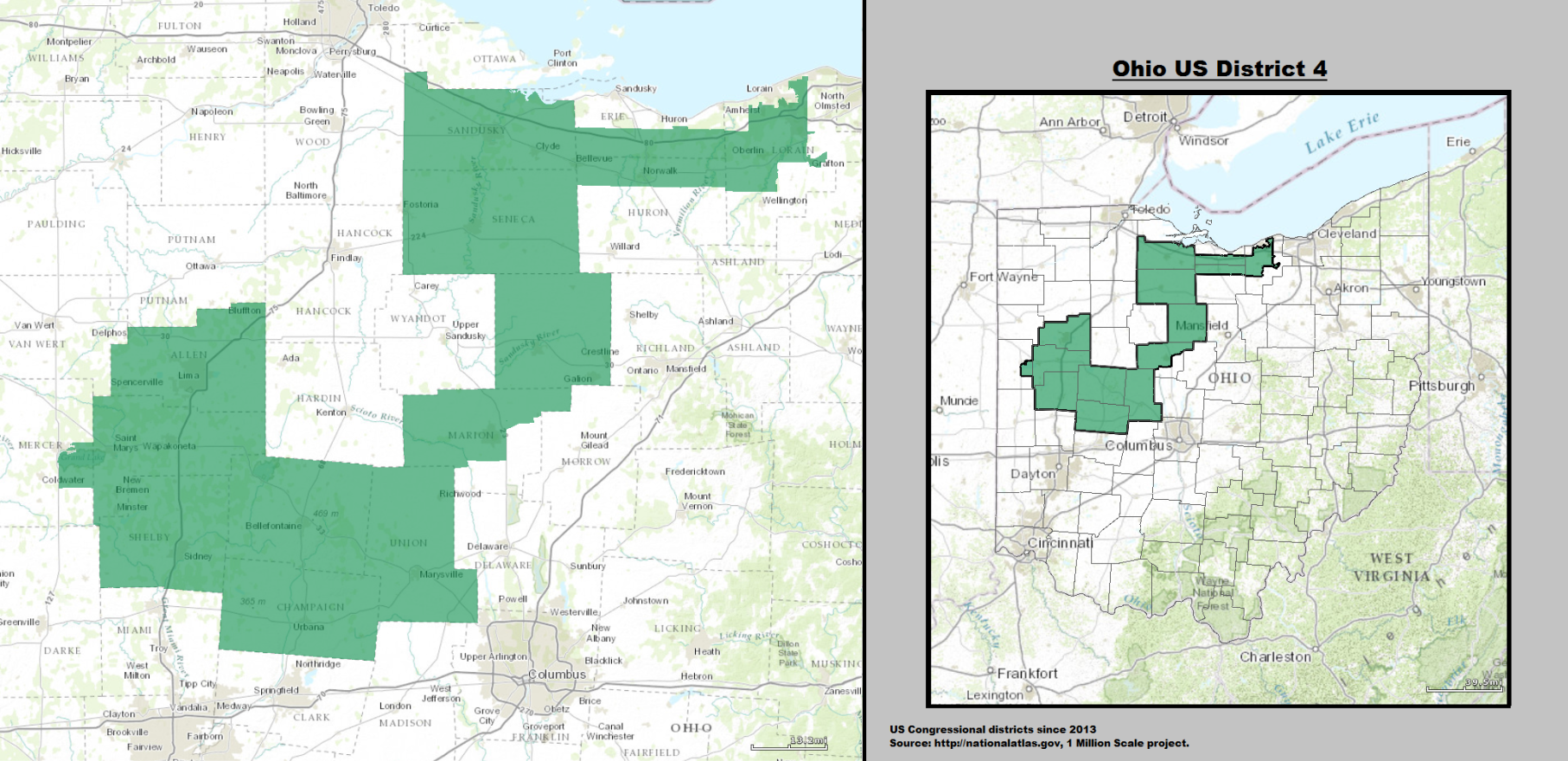Ohio’s 4th Congressional District isn’t the longest in the state nor the most convoluted. Nor does it have the most disenfranchised voters. It’s near the top of all three categories, but it also has the distinction of being home to one of the most liberal communities in the country represented by one of the most conservative members of Congress.
This is the story of Oberlin and Urbana, and the 14-county Congressional district that connects them.
"The district is commonly referred to as Ohio’s duck, with its bill shoved into portions of Lorain, Huron and Erie counties,” says Ohio State University professor Ned Hill.
In Hill’s description of the 4th, Oberlin is toward the tip of the bill. Much further north and you’re in Lake Erie. About the only place further east is Grafton, whose 3,300 prison inmates boost the district’s population and share of African-Americans – while not a single one is allowed to vote.
Ohio’s Most Liberal City
On one prominent corner of downtown Oberlin is the First Church – literally. A banner with the image of Joseph, Mary and Jesus proclaims in English and Spanish that immigrants and refugees are welcome. Across the street, one historic plaque notes that the town’s resistance to slave catchers earned it the description as “the town that started the Civil War.”

Oberlin is the first city in Ohio to turn Columbus Day into Indigenous People's Day. It's home to the first co-ed and interracial college in the country, which gives the town of about 8,300 an outsized national – and very liberal – reputation.
Janet Garrett, a retired teacher and Democrat who is preparing for her third long-shot run to represent the 4th District, says she grew up admiring the activism of Oberlin College students in the ‘60s.
“They were my heroes,” Garrett says. “They were active in the antiwar protests, the women’s rights movements and the civil rights movement.”
Head three hours southwest, to the belly of the 4th District duck, you're in Urbana and the politically red farms and small towns of Champaign County.
Clayton Colbert has lived “nine-tenth of my life here and one thing to say about Urbana is it’s like Mayberry."

Ohio’s Most Conservative Congressman
Urbana has about 12,000 people. The town square is a circle, and heavy truck traffic rumbles through as a statue of a mournful Union Calvary officer keeps watch. Storefronts are mostly full of local businesses.
About three miles out of town is the home of Rep. Jim Jordan, whose website proclaims him one of the most conservative members of Congress. He “believes that families and taxpayers, rather than government, know best how to make decisions with their money.”
Jordan is a leading member of the of the House Freedom Caucus and got a lot of applause when he spoke to the Conservative Political Action Conference last year.
“Ladies and gentleman, why you are here, why are involved in this movement, why you are conservatives is because freedom really counts,” Jordan said.
https://www.youtube.com/watch?v=sneMqveXIb4&feature=youtu.be
But Jordan has remained close to home, not far from the high school where he was four-time state champion wrestler. And many in the area say he represents their values well.
“I feel he’s a pretty stand-up guy," says Steven Flora.
Flora graduated from Graham High School about 10 years after Jordan and has started a landscaping business.
“He represents the small community and what this country was built on, the standards and the moral compass, and I feel that he goes by that for the most part and tries to sculpt the nation continue to be that way,” Flora says.
Back up in Oberlin, City Council president Ronnie Rimbert views it differently.
“The only time I see Jim Jordan is on TV, when he’s saying Donald Trump’s a great man,” Rimbert says.
Rimbert blames the divide on the Congressional district map Ohio’s Republican lawmakers created in 2011. He says the map slices up communities, stretches districts to ridiculous lengths, ensures GOP dominance and diminishes voters – especially those of different political stripes.
“It’s unfortunate that this nasty game is being played, as far as the gerrymandering game,” Rimbert says. “Jim could care less about what’s going on in Oberlin because he knows what our voter strength is, and it’s definitely not going his way.”

Who Is Represented?
Back down south in Urbana, Mayor Bill Bean says Jordan’s been a good representative, but acknowledges geography favors Urbana. He calls it literally the luck of the draw.
"Fortunately, Jim lives here, so I see Jim off and on throughout the year and I can chew on him or whatever,” Bean says.
But, while he sees Oberlin’s point, he says all parts of the 4th District and the rest of Ohio should keep Washington in distant perspective. Bean says government works best when it's closer to home.
“We have to take care of ourselves,” he says.
Though Ohio’s constitution leaves it the state Legislature to draw the congressional map, the current configuration was constructed largely in secrecy by GOP consultants under then-House Speaker John Boehner’s direction. Before he retired from Congress, the Repbulican Boehner battled Jordan and other arch-conservatives.
It's a rift that hadn't healed, even as recently in October when, in an interview with Politico, Boehner called Jordan a "legislative terrorist" among other choice words.
Congressional hopeful Garrett says that enmity may be a clue on what brought liberal Oberlin into the conservative 4th.
“I heard that part of the reason he gerrymandered this part of the Lorain County into the 4th district was to be a thorn in Jim Jordan’s side,” Garrett says.
Garrett isn’t sure if that’s true or a joke. But she maintains the map is no joke. In her mind, it’s a threat to democracy.
Ohio’s 4th District, By The Numbers:
- Population: 721,717
- Gender: 50.1 percent male; 49.9 percent female
- Race: 90.4 percent white; 5.6 percent black (including several of Ohio's largest prisons, whose inmates cannot, by law, vote)
- Median household income: $45.326
- High school graduation rate: 88.8 percent
- College graduation rate: 15.8 percent





